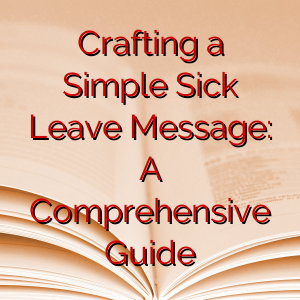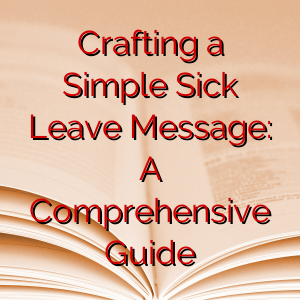Writing an Efficient Simple Leave Message
In the realm of workplace communication, one skill that often goes unnoticed is the ability to craft a concise, yet comprehensive simple leave message. Such a message informs your seniors and colleagues about your unavailability, ensuring a smooth workflow even in your absence. Understanding what exactly a simple leave message is, why it’s important, and how to draft it effectively is crucial for any professional.
What is a Simple Leave Message?
A simple leave message is a short, professional communication sent to your team and seniors notifying them of your absence from work. It is succinct and straightforward, containing key details like the reason for your absence, the duration of the leave, and, if applicable, who will cover your duties during this period.
class="font-bold text-gray-800 text-h3 leading-[36px] pt-[21px] pb-[2px] [&_a]:underline-offset-[6px] [&_.underline]:underline-offset-[6px]" dir="ltr">How to Write a Simple Leave Message: A Step-by-step Guide
To help you grasp the art of crafting a simple leave message, let’s look at five different examples, each tailored to reflect the primary keyword and cater to user search intent:
Example 1:
“Subject: Short Leave Notice. Dear [Manager’s Name], I am writing to let you know that I need to take a day off due to personal reasons. I expect to be away for [number of days]. My duties will be covered by [colleague’s name]. Thank you for your understanding.”
Example 2:
“Subject: Leave Notice. Dear [Manager’s Name], I’m informing you that I need to take a leave for [number of days]. [Colleague’s name] will oversee my responsibilities during this time. I appreciate your understanding.”
Example 3:
“Subject: Absence Notice. Dear [Manager’s Name], I will be away for [number of days] due to personal circumstances. [Name of colleague] has kindly agreed to manage my tasks during this period. Thank you for your consideration.”
Example 4:
“Subject: Request for Leave. Dear [Manager’s Name], I need to take a leave for [number of days] for personal matters. [Name of a colleague] will handle my responsibilities in the interim. Thanks for your understanding.”
Example 5:
“Subject: Leave Application. Dear [Manager’s Name], I require a leave for [number of days] due to personal reasons. [Name of responsible colleague] will cover my tasks during my absence. I appreciate your understanding.”
FAQs on Simple Leave Messages
Q1: What should a simple leave message include?
Ans: Your message should succinctly state the reason for your leave, its duration, and your plan for managing your tasks during your absence.
Q2: How detailed should my reason for leave be in a simple leave message?
Ans: You only need to mention that you have personal matters to attend to. There’s no need for specific details unless they directly impact your work over a prolonged period.
Q3: What if my leave extends more than the initially stated period?
Ans: If your leave goes beyond the stated duration, send an update via a follow-up message explaining the situation and your plan to manage your duties.
Conclusion
Crafting a simple leave message is a critical professional skill that fosters efficient communication and work management. By understanding the elements that go into such a message, you can ensure your responsibilities are suitably covered during your absence. Our comprehensive guide, with its practical examples and FAQs, should assist you in creating effective leave messages, ensuring seamless communication in your professional environment.

Hello! Welcome to my Blog StudyParagraphs.co. My name is Angelina. I am a college professor. I love reading writing for kids students. This blog is full with valuable knowledge for all class students. Thank you for reading my articles.




